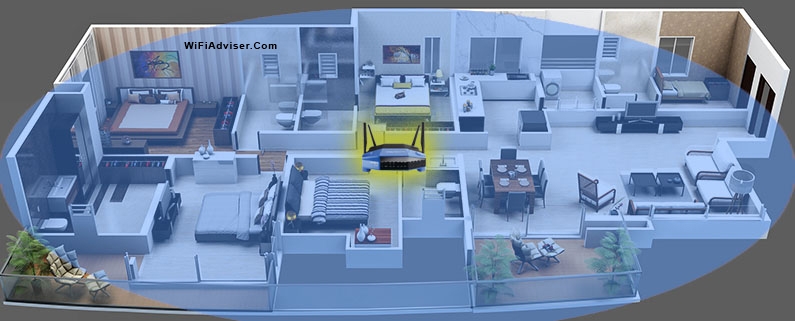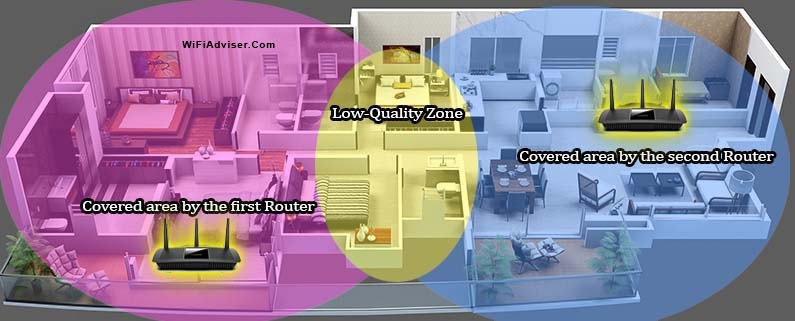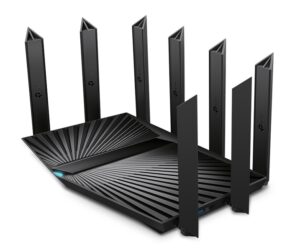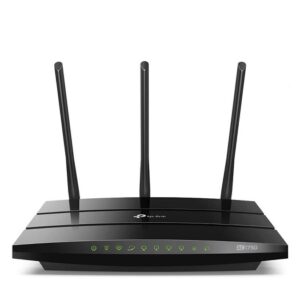Best Long Range WiFi Routers 2024
In today’s hyperconnected world, a reliable WiFi connection is essential for seamless streaming, gaming, and uninterrupted work. However, for those with large homes or those who frequently experience connectivity issues in far-reaching areas, traditional WiFi routers often fall short. This is where long-range WiFi routers step in, providing extended coverage and ensuring a robust signal throughout your entire home.
What is a long range router?
A long-range WiFi router is designed to provide reliable and consistent wireless internet connectivity over a larger area than standard routers. This is particularly beneficial for homes with large square footage or those with thick walls that can interfere with the signal. Long-range routers typically feature multiple high-powered antennas that emit signals in multiple directions, as well as advanced beamforming technology that focuses the signal towards connected devices. This combination of features ensures that the signal can penetrate walls and reach devices even in far-off corners of the home.
Long-range routers are also equipped to handle more devices simultaneously, making them ideal for homes with multiple users who rely on the internet for work, streaming, gaming, or other activities. They typically offer a wider frequency band of 5GHz, which can handle more data than the 2.4GHz band, resulting in faster speeds and smoother performance.
Long Range Router vs. Regular Router
Regular WiFi routers typically offer a coverage radius of around 1,500 square feet. This is sufficient for smaller homes or apartments, but for larger spaces, the signal may struggle to reach every corner. Long-range WiFi routers, on the other hand, are designed to overcome these limitations, expanding coverage to 3,000 square feet or more.
Long-range WiFi routers employ a combination of features to achieve their expansive coverage. These include:
Output Power: Long-range WiFi routers usually have a higher power output, resulting in stronger signals. This ensures a better reception even at longer distances or through obstacles such as walls or floors.
The output power of regular router is usually between 100mw(20dBm) and 250mw(23dBm) while in long range wifi router, it’s around 500mw(27dBm) to 800mw(29dBm).
Antenna Gain: Normally, the antenna in regular router has a gain of 2dBi (dBi is the unit for measuring antenna strength) while the antenna in long range router has a gain of 5dBi. The higher the gain in an antenna, the larger the size, so you can easily distinguish a 2dBi antenna from a 5dBi one.
Number of Antenna: More antennas on on a router increases the signal strength and overall speed of the router. A long range wifi router serves a high number of users. So, it should have more antennas compared to a regular router to guarantee the connection quality of all users. Regular router has one or two antennas while long-range routers have more than three.
Beamforming Technology: Beamforming intelligently directs the signal towards connected devices, minimizing interference and optimizing performance. This technology increases the coverage up to 40%. Read More : What is Beamforming ?
Wider Frequency Bands: Long-range routers utilize both the 2.4GHz and 5GHz frequency bands, offering a wider bandwidth for faster data transfer.
More Processing Power: Since a long range wifi router covers a larger area than a normal router, it can serve a higher number of users and devices. For this reason, most of them are equipped with a more powerful processor (and memory ) than regular routers.
Interference Handling: Long-range WiFi routers incorporate advanced interference handling techniques to combat any potential signal disruption caused by other electronic devices or neighboring networks. This ensures a more stable and reliable connection over longer distances.
Cost: Typically, long-range WiFi routers are more expensive than ordinary routers due to their advanced features and improved performance. The additional technology and components required to achieve the extended range contribute to the higher price.
What are the Benefits of long range WiFi Router?
As it’s obvious, a long-range router covers more area compared to a regular router. You can cover a large house or office using a long-range router or several regular routers. As you can see below , you can use one Long Range Router to coverage a large house (with more than -65dBm signal level everywhere):
Long Range WiFi Router Coverage

The Powerful Coverage of a Long-Range WiFi Router
You can also use two or more regular routers instead of using one long-range router to cover this house, but consider in mind :
- Routers may interfere with each other and reduce the overall quality of users’ communication.
- Connecting these routers to the modem can be a technical challenge ( Wired or Wireless).
- Users who move between routers may experience disconnections ( Yellow Area ).
Using Two Regular Routers for full WiFi Coverage (with more than -65dBm signal level everywhere).
Regular WiFi Router Coverage

Each Regular WiFi Router Covers a Part of the House, The overlapping part is inevitable
Important Note: In WiFi networks, users are served in turn. This means that as the number of users increases, the overall quality of the service decreases. Therefore, try not to use a long range wifi router in crowded places such as movie theaters and stadiums.
How to check the Signal level?
you can check the signal strength at any area of your house or workplace by using “WiFi Analyzer” applications on your tablet or smartphone. This apps display the WiFi signal strength in real-time using visual methods and charts.
Read More : Best WiFi Analyzer Tools
The average WiFi signal strength is about -80dBm to -35dBm (dBm is the unit of signal strength measurement). A larger number (a number closer to zero) means a higher signal strength. Your signal strength shouldn’t be less than -65dBm if you want to have good, high-quality wireless service.
The Maximum Power of WiFi Router is Limited …!
Keep in mind that raising the power of a WiFi router has a very important technical limitation. As you know, wireless communication is a reciprocal operation, when a client receives WiFi signals from a router, it should be able to respond to the router. For this reason, the power of WiFi router is LIMITED by the power of WiFi client. Let me explain more:
- Imagine a client is located 1 mile away from a router. In this case, the router’s signals may reach the client (due to the powerful antenna and the high output power of the router), but do the client’s signals also reach the router? Definitely not
Conclusion
Long-range WiFi routers have revolutionized home connectivity, providing seamless coverage for even the most expansive spaces. With their advanced features and exceptional range, these routers ensure that every corner of your home enjoys uninterrupted internet access, empowering you to work, stream, and connect with ease, no matter where you are in the house.
With our list of the best long-range WiFi routers in 2024, you can make an informed decision that suits your needs and budget.
Best Long Range WiFi Routers
The market has plenty of options for consumers, but finding the best long-range WiFi router can be complex. The good news is that we’ve put together a comprehensive list of the top long-range WiFi routers in 2024.
- NETGEAR Nighthawk RAXE300 (AXE7800)
- TP-Link Archer AX90
- ASUS ROG GT-AC5300
- LTP-Link AC1750 WiFi Router (Archer A7)
NETGEAR Nighthawk RAXE300 (AXE7800)
Wireless Standard: WiFi 6E
Overall Speed: 7200Mbps
Range: Very Large House
Concurrent Clients: 40
Features: Armor Security System
Ports: 4 * 1Gbps LAN / 1 * 2.5Gbps or 1 * 1Gbps WAN / 1 * USB C
Approx. Price ≈ 280$
Pros
Cons
Summary :
This router supports WiFi6E standard and is able to serve users at a speed of 7200Mbps. This Wi-Fi router equipped with a Multi-Gig WAN port. Due to the use of very special antennas and the presence of beamforming technology, the coverage level is excellent. Read More : Netgear Nighthawk RAXE300 WiFi 6E Review.
TP-Link Archer AX90 (AX6600)
Wireless Standard: WiFi 6
Overall Speed: 6600Mbps
Range: Very Large House
Concurrent Clients: 60
Features: Onemesh/HomeShield
Ports: 3 * 1Gbps LAN / 1 * 2.5Gbps + 1 * 1Gbps WAN / 1 * USB 3 / 1 * USB 2
Pros
+ Premium Security Service
Cons
– Low RAM
Summary :
This Wi-Fi router is the best long range wireless router and can cover a 4-bedrooms house. The premium security service guarantees the best security level for your home network. One of the best feature is the IoT compatibility. The reporting system is very useful for managing whole network’s users and devices. Read More : TP-Link Archer AX90 (AX6600) Review.
Asus ROG Rapture GT-AC5300
Wireless Standard: WiFi 6
Overall Speed: 5300Mbps
Range: Very Large House
Concurrent Clients: 50
Features: AiRadar , AiMesh , AiProtection
Ports: 8 * 1Gbps LAN / 1 * 1Gbps WAN / 2 * USB 3
Pros
+ Number of Antennas
+ Lifetime Internet Security
Cons
– Heavy Weight
Summary :
We have performed technical tests on this router. Including security testing, speed testing in 4K online games, file transfer speed testing in high-noise and low-noise environments. We also test the Connection stability and dedicated gaming capabilities. In the end, we gave this router a score of 8.5 out of 10, which is a very good score for a gaming wifi router. Asus ROG Rapture GT-AC5300 Review.
TP-Link Archer A7 (AC1750)
Wireless Standard: WiFi 5
Overall Speed: 1750Mbps
Range: Large House
Concurrent Clients: 30
Features: Onemesh
Ports: 4 * 1Gbps LAN / 1 * 1Gbps WAN / 1 * USB 2
Pros
+ High Performance Antennas
Cons
– Low RAM
Summary :
The best long range Wi-Fi router with lowest price. This wireless router equipped with 3 high performance antennas along with high power signal amplifier, to make a fantastic coverage. The reasonable price has made this router one of the most popular home routers. Read More: TP-Link Archer A7 (AC1750) Review.









